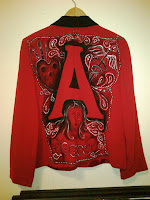“Send a business jacket. Please do not send jackets made of seersucker, corduroy, knit, denim, leather or stretch fabric, as they are hard to paint on. Also this is a business jacket on purpose, we are painting on the “uniform” of the conference attendee. Fabrics that work well are poly-blends, linen, cotton and wool. Also you might want to by a jacket a size larger than you usually do as the painting will stiffen the back and make it harder to close the buttons.”
So you sent me, or one of the other artists, a jacket and wore it to conference after conference and now it needs to be cleaned.
The only problem: There is a painting on your jacket! Now the painting itself isn't really the problem. If you have ever stained your clothes with acrylic you know how hard it is to get the paint out. The problem is the fabric. Some fabric will bend and warp around the painting if you try to clean them.
The only problem: There is a painting on your jacket! Now the painting itself isn't really the problem. If you have ever stained your clothes with acrylic you know how hard it is to get the paint out. The problem is the fabric. Some fabric will bend and warp around the painting if you try to clean them.
Wash It
 If your jacket is polyester or a mostly poly blend you can probably wash it on the delicate cycle with cold water and lay flat to dry. Many of the women’s blazers are poly blends; very few of the men’s jacket are made of this material.
If your jacket is polyester or a mostly poly blend you can probably wash it on the delicate cycle with cold water and lay flat to dry. Many of the women’s blazers are poly blends; very few of the men’s jacket are made of this material.If it is a cotton poly, or stretch cotton, you can hand wash, pat dry and dry flat. Again this applies mostly women’s blazers.
My jacket is poly and I have washed it at least 12 times with minimal fade of the paint.
Spot cleaning.
Men’s jackets are often made with natural fibers and cannot be hand washed. Some gallery members have spot-cleaned their jackets with Dryel.
Also Lysol air freshener applied to areas of odor can help keep your jacket nice.
Ironing.
You can iron your natural fiber gallery jacket. Just place a towel on top of painting when you iron in that area. Do not let the iron touch the painting directly; it will melt it. If the jacket itself is not wrinkled and the painting is sometimes you can just warm the painting with a blow dryer to release the wrinkles.
Dry Cleaning
This can be challenging. You might want to go to a pro shop that handles vintage clothing. Some of the solvents used in dry cleaning are pretty corrosive. A drycleaner who works with vintage garments should be able to clean with steam and few harsh chemicals.
But you could be like gallery member Ted Eytan who threw caution to the wind. He just dropped it off at his cleaners without telling them about the painting. It has been cleaned several times without harm.
Good Luck! And please share your cleaning tips in the comments section with the rest of the gallery.
